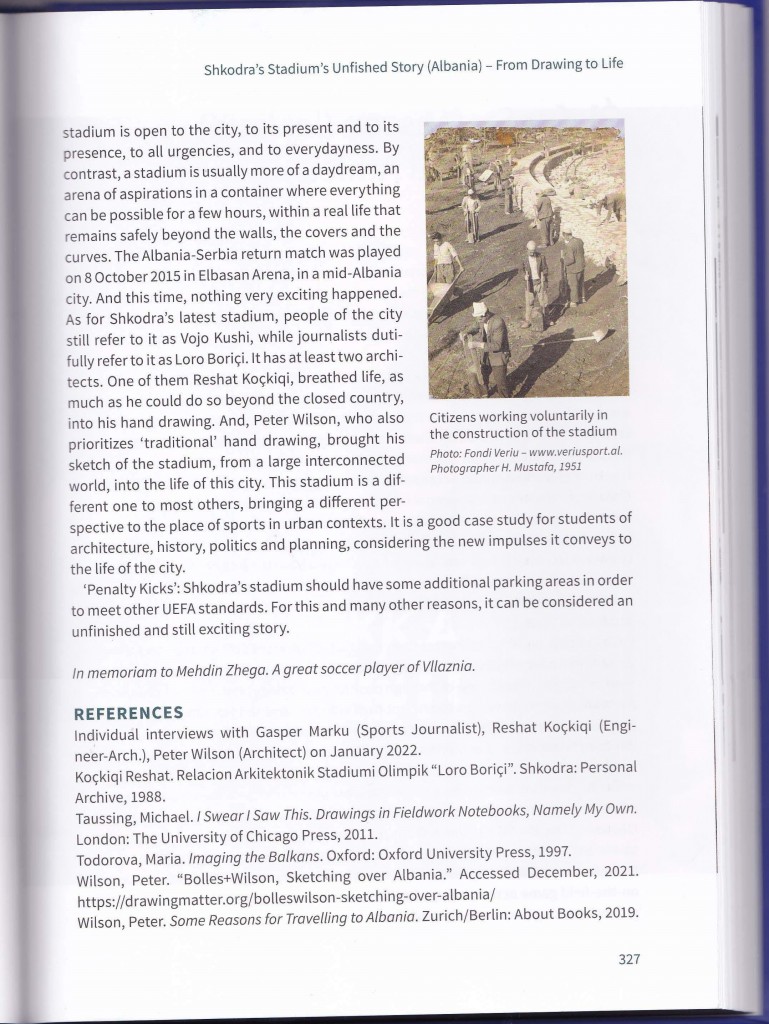
“Shkodra’Stadium Unfinished Story. From Drawing to Life” in A History of Sports in Europe in 100 Objects.

A History of Sports in Europe in 100 Objects is a very useful resource to historians, policy makers, sports amateurs, professionals as well as designers. The book can be briefly described as:
“European Sports History materialized From ancient boxing fresco to the Champions League trophy. Modern sport originated in Europe. During the age of Enlightenment, gymnastics and athletics from Antiquity were rediscovered and changed into new cultural and educational forms, which shaped both the body and the mind.
The 100 objects that are collected here are both material objects and forms of communication which explore the transformation and diversity of sports, games and physical education in Europe whether for training, performing or as part of other forms of celebration or festivity.
This book is the first attempt to create a kaleidoscopic history of European sport through its rich material culture and emerged from a desire to develop transnational research in sports history. 110 authors from 39 countries have participated in a genuinely pan-European project, introducing the reader to the fascinating range of people, institutions and places which made up the world of modern European sport.
The book is edited by Daphne and Michael:
Daphné Bolz is professor of sports history at the University of Rouen Normandy (France) and a former Marie Sklodowska Curie Fellow in Leicester (UK), Berlin and Münster (Germany).
Michael Krüger is professor of sports pedagogy and sports history at the University of Münster (Germany).”
#sportshistory#architecturalhistory#balkans#europe#shkodra#objects#space#concrete
Since the end of 19th century sports would get particular attention from national governments. Sports as activity and sports venues would be considered as means par excellence of formatting physically and politically the national citizen. The relationship of state and sports has changed a lot since then. However, sports-power correlation is still quite dense and definitely not a simple one.
I explore this subject in my article : Football games or power struggles? The Albanian case within historical conflicts and contemporary tensions.
The article is based on hundred pages of archival research on interwar Albania when the whole cultural and sport life in the country was being reshaped. It then uses contemporary policy texts, events, news and interviews to bring in dynamics related to the beginning of 2000’s.The article belongs to the domain of social history because its starting point is the society, sports clubs and associations. It does not include into the analysis the spatial transformation that was started in order to determine the relationship the state would have with sport associations and sport life in the country.
On the contrary, the most recent article Shkodra’s Stadium Unfinished Story. From Drawing to Life belongs to the architectural history domain for it takes as a starting point the reconstruction of Shkodra’s stadium in order to scrutinize the impact of sports in a city’s life, and review the power-culture-sport dynamics. In this regard it questions how a stadium reconstruction is impacted by historical and social dynamics and vice versa.
…
Silence reigned in the city. Cars stopped. Bicycles parked. Streets emptied. And, we the kids, instead of playing in our usual space between the socialist buildings, moved around very calmly paying an ear. Men were in the stadium. Vllaznia was playing. The city waited impatiently the sound waving out of the stadium: Goooal! Vllazniaaaaa! Vllazniaaaa! And rhymes of the kind : “Vllaznia Perênd’ia!
If this happened, the week ahead was going to be a joyful one, no matter the regime, no matter the economy, no matter any daily stressful event. The stadium was the beating heart of the city for it was essential to collective life, individual memories, and various identifications.
However, I would analyze later on, intellectually and scientifically these times, clubs, sports events, and arenas, I would never forget the names of those that made us yell and cry out of joy.
This is why Shkodra’s Stadium Unfinished Story is dedicated to Mehdin Zhega, a great sportsman, a great football player, a fair player of the city that made me adore sports, and be as much critical towards it, but particularly towards its relationship to power. Some sport fans and amateurs in particular would very well understand what I mean with this latest.
…
